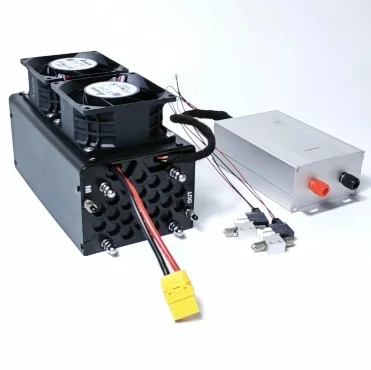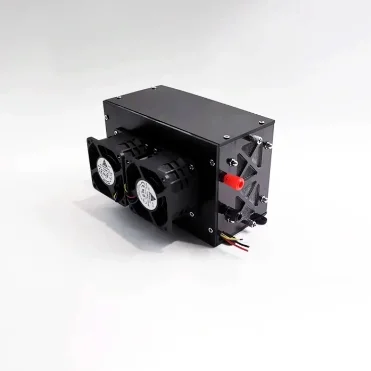Hydrogen fuel cell stacks are revolutionizing clean energy solutions, offering efficient and eco-friendly power generation. These innovative devices convert hydrogen into electricity through a chemical process, emitting only water vapor as a byproduct. With their scalability and versatility, hydrogen fuel cell stacks are driving advancements in transportation, stationary power systems, and portable electronics. The technology's potential to reduce greenhouse gas emissions and dependence on fossil fuels makes it a key player in the transition to sustainable energy sources.
Understanding the Basics of Fuel Cell Stacks
How Fuel Cell Stacks Work
A fuel cell stack operates by producing electricity from an electrochemical reaction. It comprises several individual fuel cells linked together to generate power continuously. Each fuel cell contains an anode, a cathode, and an electrolyte membrane that facilitate the chemical reactions necessary for electricity production.
Fuel cell stacks are versatile and can be used in various applications due to their ability to efficiently convert hydrogen into electricity. The process involves hydrogen entering through the anode side and oxygen (or air) flowing through the cathode side. As hydrogen molecules split into protons and electrons at the anode, electrons travel through an external circuit, creating electrical current.
Pros:
Efficient energy conversion
Environmentally friendly operation
Components of a Fuel Cell Stack
The size and power output of a fuel cell stack can differ based on its intended use. Key components include bipolar plates that distribute gases evenly among cells, gas diffusion layers aiding in uniform gas distribution, catalyst layers promoting chemical reactions, and flow fields ensuring proper air flow rates within each cell.
Inlet air plays a crucial role in maintaining optimal performance within a fuel cell stack by regulating temperature levels throughout operation. Ensuring consistent air flow rates is essential for preventing overheating or underperformance issues that could impact overall efficiency.
Anode: Where hydrogen enters
Cathode: Where oxygen (or air) flows
Electrolyte membrane: Facilitates chemical reactions
Key Components of Hydrogen Fuel Cell Stacks
Anode, Cathode, and Electrolyte
Hydrogen fuel cell stacks consist of three main components: the anode, cathode, and electrolyte. The anode is where hydrogen gas is oxidized to produce protons and electrons. On the other hand, at the cathode, oxygen combines with electrons and protons to form water. The electrolyte in a fuel cell stack acts as a medium for ion transport between the anode and cathode.
The Proton Exchange Membrane (PEM) serves as the electrolyte in many hydrogen fuel cell stacks. It allows only positively charged ions (protons) to pass through while blocking electrons' flow, facilitating the electrochemical reactions within the stack. This selective permeability helps maintain efficiency by preventing electrical short circuits within the system.
Bipolar Plates
Bipolar plates play a crucial role in hydrogen fuel cell stacks by distributing reactant gases evenly across the surface of each electrode while collecting electrical current generated during operation. These plates are typically made from materials like graphite or metal coated with corrosion-resistant substances to ensure durability under harsh operating conditions.
The Chemistry Behind Hydrogen Fuel Cells
How Hydrogen Gas Powers the Anode
Hydrogen fuel cells work by supplying hydrogen gas to the anode, where it undergoes a process called electrolysis. During this process, hydrogen molecules split into protons and electrons. The protons then move through the proton exchange membrane towards the cathode.
The movement of protons creates an electrical current within the fuel cell stack. This flow of electricity is what powers various devices or vehicles that utilize hydrogen fuel cells as their energy source.
Oxygen's Role at the Cathode
At the cathode, oxygen from the air combines with both protons and electrons that have traveled through individual cells in the fuel cell stack. This combination results in a chemical reaction that produces water as a byproduct.
Pros:
Environmentally friendly energy source.
High efficiency compared to traditional combustion engines.

Advantages of Using Hydrogen Fuel Cell Stacks
High Energy Efficiency
Hydrogen fuel cell stacks boast high energy efficiency when compared to traditional combustion engines. This means that a greater percentage of the energy stored in hydrogen is converted into usable power for vehicles. As a result, they can go farther distances using less fuel, making them more efficient overall.
Pros: Greater mileage per unit of fuel, reduced energy waste.
Cons: Initial high costs may deter some consumers from investing.
Zero Greenhouse Gas Emissions
One significant advantage of hydrogen fuel cell stacks is their ability to produce zero greenhouse gas emissions during operation. Unlike internal combustion engines that release harmful gases like carbon dioxide and nitrogen oxides, fuel cells only emit water vapor and heat as byproducts. This contributes to cleaner air quality and helps mitigate climate change by reducing the carbon footprint associated with transportation.
Key Information: Environmentally friendly alternative to traditional fossil fuels.
Longer Operating Ranges and Faster Refueling Times
Another key benefit of utilizing hydrogen fuel cell stacks is their capability to provide vehicles with longer operating ranges and significantly faster refueling times compared to battery-powered vehicles. Electric cars powered by batteries often require longer charging times, limiting their practicality for long-distance travel. In contrast, hydrogen fuel cell vehicles can be refueled in minutes similar to conventional gasoline-powered cars.
Hydrogen fuel cells offer extended driving ranges without compromising performance.
The quick refueling process makes them more convenient for everyday use.
Application Areas of Hydrogen Fuel Cell Stacks
Transportation Applications
Hydrogen fuel cell stacks are crucial in various transportation modes like cars, buses, and trains. These applications enable vehicles to run efficiently while producing zero harmful emissions. For instance, hydrogen fuel cell-powered buses have gained popularity in cities aiming to reduce pollution levels.
Fuel cell stacks also play a significant role in making cars more environmentally friendly by providing a clean energy source for propulsion. The use of these fuel cells in trains contributes to reducing greenhouse gas emissions and dependence on fossil fuels for locomotion.
Stationary Power Generation
In stationary power generation, hydrogen fuel cell stacks are utilized to provide electricity for buildings, remote areas with limited access to the grid, and as backup power systems. The versatility of these fuel cells allows them to serve as reliable sources of energy during power outages or in off-grid locations where traditional electricity supply is unavailable.
The application of hydrogen fuel cell stacks in stationary power generation offers a sustainable solution for meeting the energy needs of various facilities without contributing to air pollution or greenhouse gas emissions. This makes them ideal for ensuring continuous power supply while minimizing environmental impact.
Portable Devices
Another exciting area where hydrogen fuel cell stacks can be applied is in portable devices such as laptops and smartphones. By integrating these fuel cells into electronic gadgets, manufacturers can enhance battery life significantly compared to conventional lithium-ion batteries. This advancement could revolutionize the way we use portable electronics by extending usage time between charges.
Bullet List:
Enable vehicles with zero harmful emissions.
Provide clean energy for cars, buses, trains.
Offer reliable backup power solutions.
Enhance battery life in laptops and smartphones.
The Role of Hydrogen in Sustainable Transportation
Decarbonizing the Transportation Sector
Hydrogen fuel cell stacks are pivotal in reducing carbon emissions and combating climate change. Unlike traditional vehicles that rely on fossil fuels, hydrogen fuel cell vehicles emit only water vapor as a byproduct. This makes them an environmentally friendly option for transportation. By utilizing hydrogen fuel cells, the transportation sector can significantly decrease its carbon footprint, contributing to a cleaner and greener environment.
Pros:
Reduces carbon emissions
Environmentally friendly alternative to fossil fuels
Viable Alternative to Fossil Fuels
The use of hydrogen fuel cell stacks offers a sustainable solution by decreasing reliance on finite resources such as oil and gas. As these resources continue to deplete, transitioning to hydrogen-powered vehicles becomes increasingly crucial. Moreover, hydrogen is abundantly available and can be produced through various methods like electrolysis of water or steam reforming of natural gas.
Key Information:
Decreases dependence on finite resources like oil and gas
Examples:
Toyota Mirai
Hyundai Nexo
Revolutionizing Long-Haul Trucking
One of the most promising aspects of hydrogen-powered vehicles is their potential to transform long-haul trucking and heavy-duty applications. The extended driving range offered by hydrogen fuel cells makes them ideal for commercial use where longer distances need to be covered without frequent refueling stops. With advancements in technology and infrastructure development, we can expect a significant shift towards using hydrogen fuel cell stacks in heavy-duty transportation sectors.
Steps Towards Implementation:
Develop more efficient hydrogen storage solutions.
Expand the network of hydrogen refueling stations nationwide.
Guidance for Adoption:
Encourage government incentives for purchasing hydrogen-powered vehicles.
Collaborate with industry stakeholders to promote research and development.

Final Remarks
The exploration of hydrogen fuel cell stacks has unveiled their intricate components, chemical processes, and diverse applications. Understanding the basics, from their composition to operational advantages, illuminates the pivotal role hydrogen plays in sustainable transportation. These insights underscore the promising future of hydrogen fuel cell stacks as a clean energy solution with far-reaching environmental benefits.
As industries and researchers continue to innovate in this field, embracing hydrogen fuel cell technology stands as a crucial step towards a greener tomorrow. The application areas discussed highlight the versatility and efficiency of these systems, urging stakeholders to invest in further research and implementation. By integrating hydrogen fuel cell stacks into various sectors, we pave the way for a more sustainable and eco-friendly future.
Frequently Asked Questions
What are fuel cell stacks?
Fuel cell stacks are assemblies of individual fuel cells that convert chemical energy into electrical energy through electrochemical reactions, commonly using hydrogen as a fuel source.
How do hydrogen fuel cell stacks work?
Hydrogen fuel cell stacks generate electricity by combining hydrogen and oxygen in an electrochemical process, producing water vapor as the only emission. This sustainable technology offers efficient power generation with zero harmful emissions.
What are the advantages of using hydrogen fuel cell stacks?
Hydrogen fuel cell stacks offer benefits such as high efficiency, zero greenhouse gas emissions, quiet operation, fast refueling times, and versatility for various applications ranging from transportation to stationary power generation.
Where are hydrogen fuel cell stacks commonly used?
Hydrogen fuel cell stacks find applications in diverse areas including transportation (such as cars, buses, and trucks), backup power systems for buildings or telecom towers, material handling equipment like forklifts, and portable electronics.
Why is hydrogen considered important in sustainable transportation?
Hydrogen plays a crucial role in sustainable transportation due to its potential to decarbonize the sector by enabling the use of clean energy sources. Hydrogen-powered vehicles offer a pathway towards reducing greenhouse gas emissions and achieving long-term environmental sustainability goals.








